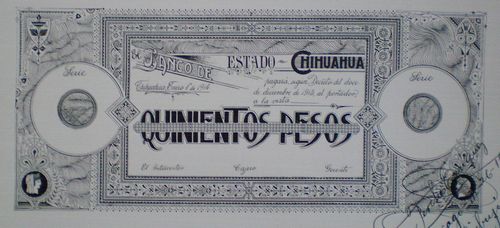El Banco del Estado de Chihuahua
The series of notes printed by the American Bank Note Company for the revolutionary Banco del Estado de Chihuahua was never put into circulation, but the bank itself actually operated for a short while.
Given the perceived hostility of banks to the lower classes, it was a commonplace amongst revolutionaries that it would never be possible to improve their lot until they had founded their own bank. Indeed, Abraham González contemplated this even before Huerta’s usurpation and Villa frequently discussed the matter.
Silvestre Terrazas
One of Abraham González’ first acts on resuming the governorship in February 1912 was to suggest that the legislature found a Banco de Crédito Agrícola to make loans to farmers and local businesses but Orozco’s revolt intervened.
Silvestre Terrazas was still pursuing the idea and on 8 August 1912 he wrote to the London Joint Finance and Credit Company, of 67-70, Fenchurch Street, London, that there were many businesses in Chihuahua keen to obtain finance for development and that the greatest need was for a banking institution in the state since most local banks were still in the wrong hands. He had spoken with President Madero and Ernesto Madero, the Minister of Finance , who were happy with the idea of a Banco Hipotecario in Chihuahua, and the Governor would authorise such a bank, if sufficient capital could be arranged ST papers, Part I, box 83, 8 August 1912. The London Joint Finance and Credit Company passed on the letter to the Anglo-European Bank, Limited, 201, Salisbury House, London whose D. J. de Xavier, on 2 September, asked for more details, such as the current rates of interest and type of collateral obtainableST papers, Part I, box 4, letter 2 September 1912. On 31 August Silvestre Terrazas wrote an editorial in his newspaper advocating, among other reforms, a state bank"La cuestión bancaria en Chihuahua", El Correo de Chihuahua, 31 August 1912.
On 24 September Ernesto Madero wrote that the federal government was in favour, but that the bank needed at least $1m in capital, and according to the Ley General 20% of its reserves should be held in Bonos de la Deuda Pública deposited with the Tesorería de la Nación or the Banco Nacional de MéxicoST papers, Part I, box 6, letter Ernesto Madero to Silvestre Terrazas, 24 September 1912. On 4 October, in response to a query from Terrazas, governor Abraham González said that, if such an institution was established, it could count on the business of the state government, in preference to any otherST papers, Part I, box 6, letter Silvestre Terrazas to Abraham Gonzalez, 1 October 1912: letter Gonzalez to Terrazas, 4 October 1912.
On 11 October Terrazas wrote to Jean Prez, in Mexico City, updating him on developments, and it seems that he was interested in English or American interests perhaps taking over a current concession (of the Banco Minero?). Andrés Pfeiffer was preparing a report on the 'cuestión bancaria local’ST papers, Part I, box 83, 11 October 1912. (Pfeiffer had been the manager of the Chihuahua City branch of the Banco de Sonora and went on to be the manager of the Banco del Estado de ChihuahuaVida Nueva, 22 September 1914).
On 1 March 1913 Terrazas wrote to Prez, confirming a conversation they had had the day before that the conditions for gaining the concession were (1) that the group of French and Belgian capitalists subscribe $1m in capital (half before the bank started); (2) that Terrazas and Prez gain as large a commission as possible for their efforts, to be shared equally; (3) that they share equally in as many founder shares as possible; (4) that they should form part of the bank’s board (Consejo de Administración); and (5) that Andrés Pfeifer be employed by the bankST papers, Part I, box 83, 1 March 1913. However, González’ administration was overthrown before anything could come of the idea.
Francisco Villa
On 12 December 1913, four days after capturing Chihuahua, Villa decreed the founding of his own bank, El Banco del Estado de Chihuahua. According to the decree, the bank would have a capital of ten million pesos. It would take over control of all the notes issued on a temporary basis by the Tesorería del Estado (the sábanas) and intended to issue ten million pesos in paper currency, to be backed by an equal sum in gold, silver and copper coinage. As this might not have inspired sufficient confidence, a fourth clause was added to the decree, as an afterthought, stating that to begin with the notes would be guaranteed by the estates confiscated from the enemies of the revolutionPeriódico Oficial, 21 December 1913 and original drafts in ST papers. Or Terrazas might have produced his first draft before it was decided to make the confiscations. The bank was to carry out all the usual banking functions, including making loans on property, especially to poorer farmers who needed funds to work their lands, but it was also envisaged as a bank of issue for notes and coins. On 2 January 1914 Associated Press reported that one of the purposes of Villa’s visit to Ciudad Juárez was to establish a state bank to handle Constitutionalist money. He had bought $100,000 in silver bullion and intended to make the bank the depository for rebel fundsDouglas Daily Dispatch, 3 January 1914. It was reported that Villa was talking to El Paso bankers to try to induce them to assist in establishing a state bank in the city of Chihuahua which would handle all of the funds of the Constitutionalist state governmentEl Paso Herald, 2 January 1914.
On 16 January 1914 Villa wrote to Carranza to ask for $5,000,000 to underwrite the bank, money that would restore confidence and allow businesses to resumeST papers.
The next day it was reported from Ciudad Juárez that a new bank of issue, to be known as “El Banco Constitutionalista de Chihuahua” would soon make a new issue. An American engraving company in the east had accepted an order to print the bank notes, which would be of much better quality than that currently in use. All the rebel money in circulation throughout Chihuahua will be recalled and exchanged for the new issueEl Paso Herald, 17 January 1914.
In the next few months arranging a new currency was a more urgent task than establishing the bank. Villa had already begun issuing the sábanas, and would soon be commissioning a definitive issue but it was not until 13 June 1914 that he charged Silvestre Terrazas with organising and founding the bank in accordance with his decree, giving him power to appoint its employees, draw up its statutes and acquire whatever assets and equipment that he needed[ ] When Villa had his interview with Serapio Aguirre in June 1914 he asked him to manage the Banco de Agricultura y Minería that he was going to establish. Silvestre Terrazas, Villa said, was studying the project. Aguirre tactfully declined, claiming that he wanted first to finish his work in the Secretaría de Hacienda..
When Villa expropriated the larger estates in Chihuahua he stated that it would be up to the Banco del Estado de Chihuahua to oversee all the confiscated properties but the bank was absolutely unprepared for this task with neither the personnel nor the experience to carry it out. As a result, Villa shifted control of the confiscated properties from the bank to a newly formed Administración de Bienes Intervenidos del Estado de Chihuahua, headed by Silvestre Terrazas.
It soon became obvious to the Villistas that the sábanas needed to be replaced by a more creditable issue, and in early 1914 they arranged the printing of the dos caritas. At the same time certain of Villa’s agents were in the United States arranging proofs for an abortive series of notes for the Banco del Estado.
It is necessary, therefore, to disentangle these different arrangements, as well as to remember that there were also Carrancista agents in the United States with similar purposes. Also one should realise that newspaper reports in the United States or Mexico could be mistaken, misguided or downright false.
Agents in the United States
Certainly two agents, Juan and Ignacio Perchez EnríquezIgnacio Perchez Enríquez was Silvestre Terrazas' brother-in-law (cuñado). On 4 August 1913 Silvestre Terrazas had written to Félix Martínez in El Paso recommending Juan Perches Enríquez, who was without a job and looking for work (ST papers, Part I, box 83), had reached the stage of preparing proofs for a Banco del Estado de Chihuahua series before their project was aborted. On 30 December 1913 Juan was commissioned by Villa to go to the United States to oversee the manufacture of plates for the bank. He was authorised to acquire the necessary materials, at the cheapest possible cost, given the quality demandedST papers. By 20 February 1914 his brother Ignacio, in El Paso, was asking for details of paper and linotypes, and four days later he reported that he had acquired 25,000 pounds of paper and a second hand machine.
On 26 March José F. Farias sent Lázaro de la Garza a folder containing twelve samples for the $5, $10, $20, $50, $100 and $500 notes of the Banco del Estado de Chihuahua signed by Juan Perchez EnríquezLG papers, 4-E.
On 6 May Ignacio was writing about the paper for the Banco de Estado notes, and on 19 June informed Villa of the difficulties that they had encountered over the printing plates. The plates that Ignacio already held would have been of little use in Chihuahua since they did not have the right equipment there and so he was going to Chicago to try to obtain enough copper or zinc plates to use on their Optimus press. The next day Ignacio acknowledged Terrazas’ instruction to increase the print run from five to ten million pesos and to use the existing stone plates. He thought that the best place to arrange the printing would be DenverDenver was probably the Smith-Brooks Printing Company. Other sources suggest that revolutionary currency was printed by this company which certainly provided postage and revenue stamps for the Constitutionalists. Orville Louis Hough, grandson of the firm’s co-founder O. L. Smith, said that he understood that Carranza sent Salvador Cataño (according to newspaper reports ‘Carranza's representative to Denver’ and ‘Commissioner of the Constitutionalist government’), to Denver in March 1914 on a secret mission. Hough recalled: "We had a drawer with samples of work we had done in the past and one day John Brooks (company secretary-treasurer) trotted out some bills. I don’t remember the denomination. I remember him telling me what I already knew, namely that it was federal money and revolutionary money. My recollection is that in the lower left hand corner beneath fancy scrollwork, I think it said ‘'Litho,’ or maybe just ‘Smith-Brooks,’ or maybe ‘S-B,’ but there was some indication where they were printed".
Ed O’Hara, a bookkeeper, recalled a story concerning Milo R. Foley, the manager of the company. "Foley used to flash the currency around as a joke. One day he was eating in a small coffee shop with his ‘stage money’ and one of the FBI men noticed it. He asked Foley about it and when he learned it was actual currency, he advised John Brooks that it should be carefully guarded and all remainders completely destroyed. That was done."’
Some people claimed that the order had been placed by Villa as an order was for the ‘Sonoran government’ after a Smith-Brooks salesman tracked Villa down and sold him the job.
John Brooks’ son, Jack, said that the job was done on a 1908 Harris Offset Press. (Ron Mitchell, Mexican Money Mystery, in Mexican Revolution Reporter, 30, February 1984), as there they would be faster, and he had another reason, that he would explain later, for it not being convenient to use San AntonioWas his reason that the Maverick-Clarke Litho Co. were already printing the dos caritas?. Two plates had been broken, possibly by the freight company, and would need to be repaired when they got to Denver but he would start off with the good plates. However, on 23 June Ignacio was instructed to hand over the plates to Lázaro de la Garza though a few days later he took over responsibility again.
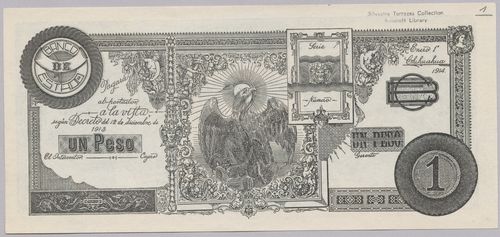
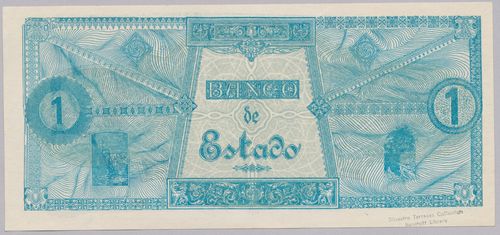 M Unlisted $1 Banco del Estado de Chihuahua proof
M Unlisted $1 Banco del Estado de Chihuahua proof
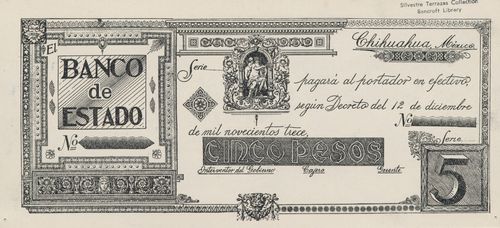
 M Unlisted $5 Banco del Estado de Chihuahua proof
M Unlisted $5 Banco del Estado de Chihuahua proof
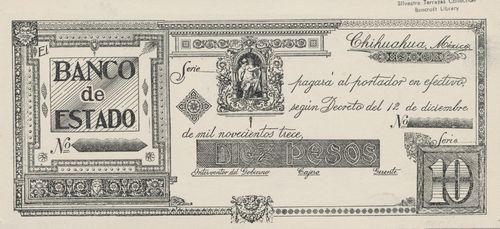
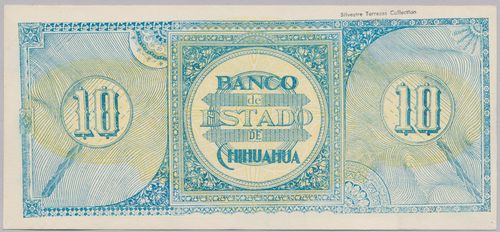 M Unlisted $10 Banco del Estado de Chihuahua proof
M Unlisted $10 Banco del Estado de Chihuahua proof

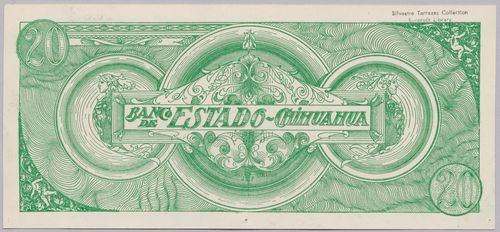 M Unlisted $20 Banco del Estado de Chihuahua proof
M Unlisted $20 Banco del Estado de Chihuahua proof
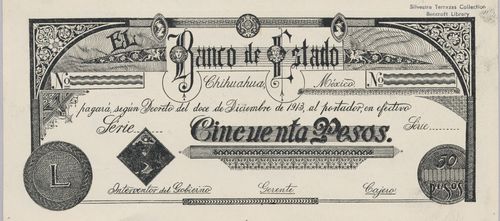
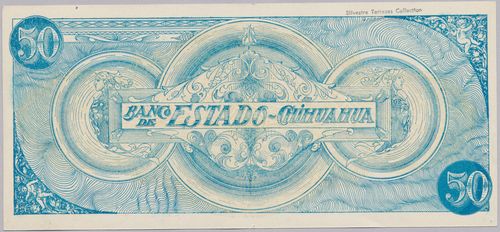 M Unlisted $50 Banco del Estado de Chihuahua proof
M Unlisted $50 Banco del Estado de Chihuahua proof
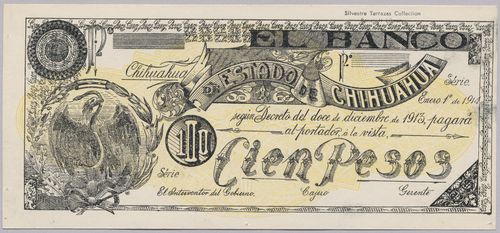
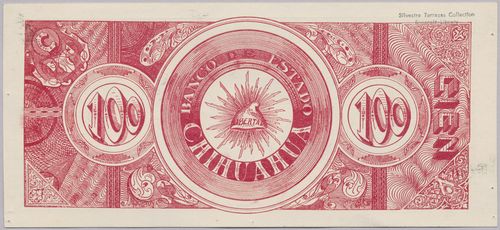 M Unlisted $100 Banco del Estado de Chihuahua proof
M Unlisted $100 Banco del Estado de Chihuahua proof
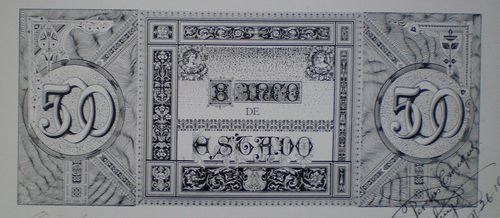
It would be satisfying to believe that these notes were aborted because the designs were so appalling, but one then needs to ask whether the Perchez Enríquez could have progressed so far without submitting their designs for approval. Of the two sets of proofs that remain, one carries the dateline ‘Chicago, 26 March 1914’. The text ‘El Banco de (sic) Estado pagará según Decreto del doce de Diciembre de 1913, al portador, en efectivo’ (and variants), dateline ‘1 January 1914, Chihuahua’, and spaces for the signatures of the Interventor del Gobierno, Cajero and Gerente are the same as on the later American Bank Note Company notes but the cluttered designs are incredibly amateurish. Surviving proofs include:
| $1 | black/white face |
| blue face | |
| green face | |
| red face | |
| blue/yellow reverse | |
| blue/green reverse | |
| green/orange reverse | |
| $5 | black/white face |
| yellow face | |
| black/white reverse | |
| blue/yellow reverse | |
| $10 | black/white face |
| yellow face | |
| black/white reverse | |
| blue/yellow reverse | |
| $20 | black/white face |
| yellow face | |
| black/white reverse | |
| green reverse | |
| $50 | black/white face |
| yellow face | |
| black/white reverse | |
| blue/yellow reverse | |
| $100 | yellow face |
| black/white reverse | |
| red reverse | |
| $500 | black/white face |
| black/white reverse |
However, other agents were now arranging a contract with the American Bank Note Company. On 16 August Juan wrote from Washington that he had been told to stop work, even though the paper was ready. He noted that he had made some slight modifications to one or two of the designs and had also registered the watermark (which appeared at least three times on each note) with the patents office. By 29 August the Norris Peters Company, the printers Juan, who suffered from a severe lack of funds, wrote on company-headed notepaper. Santiago S. Winfield, who had previously arranged the Ejército Constitucionalista contract for the Constitucionalist Finance Secretary Felicitas F. Villarreal, was involved in this contract, wanted to know if the suspension was temporary or permanent. On 1 September Juan reported that he had taken advantage of the delay to make the changes they wanted to introduce and added that the work could be done in Washington or Chicago. On 6 September Silvestre Terrazas telegraphed Juan Perchez Enríquez in Ciudad Juárez to ask whether Juan had already ordered the new issueST papers, box 83. On 13 September Juan replied that he thought that he would have time to make a new model based on certain national themes. He wanted to base the notes on Aztec or Mayan designs, and once he had finished them, would send Villa photographs for his approval. If they were acceptable he would give them to the engravers. By this time Norris Peters were demanding money on account and Juan suggested placing the work elsewhere in Chicago or New York.

